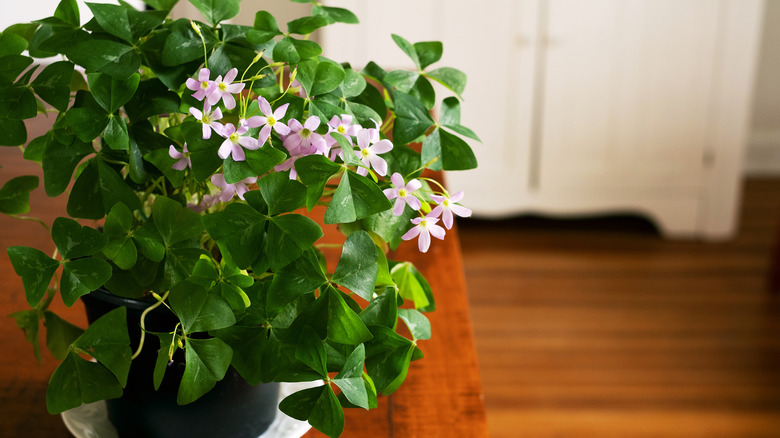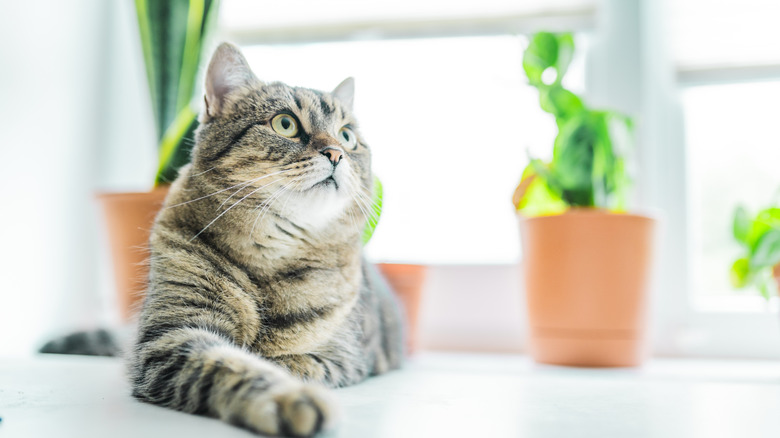The Beginner Houseplant That Will Bring Gorgeous Color To Your Home
If you want to bring new life into your home, there are few better ways to achieve your goal than through adopting a new plant. The right houseplant can bring a sense of vibrancy to any space, in addition to other benefits like improving mood and purifying the air in your home. If you're looking for a great beginner houseplant that can also bring gorgeous color to your home, you'll find all of this in the oxalis.
The oxalis is a charming shamrock-like leafed plant that produces dainty flowers in a range of hues, including yellow, white, pink and purple. The fluted shapes of the flowers paired with the shamrock-shaped leaves provide a dynamic appearance that can bring a new level of visual appeal to any space. While there are hundreds of varieties of oxalis to choose from, some of the most popular ones are the Oxalis triangularis and the Oxalis siliquosa — the former featuring purple leaves and the latter possessing leaves that change colors depending on the season. While there is much to love about the oxalis, perhaps one of the most attractive features is just how easy it is to care for. Knowing how to properly care for your oxalis can ensure the plant adds substantial beauty to your home for years to come, no matter your skill level.
Caring for your oxalis
Taking care of an Oxalis' isn't too complicated, making it ideal for individuals who might struggle to keep plants happy (or even alive). Begin by securing a good pot for your oxalis — namely one that allows for sufficient drainage. Terracotta is a great option given its porous nature. This allows excess moisture to drain easily, thereby keeping your plant healthy. Next, ensuring you have good soil for your plant will also provide positive results. Oxalis grow best in a mixture of soil and peat, which encourages a healthy balance of moisture and ventilation.
Your oxalis will also thrive in conditions that offer indirect to bright light, meaning you should avoid placing it in a low-light environment. Similarly, oxalis do well in moderate temperatures between 65 and 85 degrees Fahrenheit. If you live in a location with harsh winters and let your home get cooler in cold months, it's important to ensure the thermostat does not go below 60 degrees.
Because oxalis prefer slightly dry soil, you'll only need to water it every 1-2 weeks, which is perfect for forgetful plant parents. With that in mind, be aware of the impact that light can have on your oxalis' moisture level — with brighter environments resulting in the soil drying out faster. Also, if you have a room with higher humidity levels (like a bathroom), you may find that your oxalis thrives there.
Tips before bringing an oxalis home
If you think that an oxalis plant would be a good fit for your space, there are a few more things to consider. First and foremost, it's important to understand that oxalis plants are technically toxic to both pets and humans. Cats and dogs that ingest oxalis' leaves, stems or bulbs can suffer hypocalcemia and kidney damage from oxalate crystals. Ingestion of the plant can lead to vomiting, diarrhea, drooling, and blood in a pet's urine — requiring immediate medical attention. The same goes for humans, who may suffer from nausea, vomiting, and abdominal pain. Children are especially susceptible to serious effects as they are smaller and more likely to ingest part of this plant. If your home has pets or young children it might be best to choose a non-toxic houseplant that's safe for any space.
While oxalis are easy to care for, there can suffer from blights. If you find that the leaves on your oxalis are looking unhealthy and sporting white spots, you could have a pest infestation, mildew problem, or the plant is in too bright of a space. You can remedy these issues by pruning affected leaves, cleaning the leaves with a homemade spray, or moving the plant to a less-bright area. Similarly, if the stems and leaves of the plant are squishy, this is a telltale sign that conditions are too wet. Consider watering the plant less frequently, placing it in a brighter location, or swapping out the soil for a better-draining blend.


